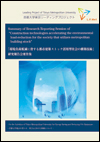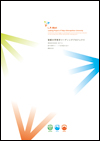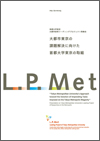Ⅲ.Project Research on Activation and Renewal of Suburban Cities
1) Project's Achievements
-Papers & Verbal presentations
(1) Utilization of empty houses as a measure to realize town development: Shin Aiba, Toshi Mondai. No.104-4: The Tokyo Institute for Municipal Research, Apr.2013
(2) "Kodomo Café" in an empty house designed, constructed and run by children: Yuki Marumo, Motoki Fujitani, Tamae Umemura, Shin Aiba: Meeting 2013 of Association for Children's Environment (Tokyo), Apr.2013
(3) Auditory and olfactory scenes of residential areas with a focus on the relation to urban space configuration elements: Kiriko Matsui, Ryo Sanuki, Tohru Yoshikawa, Noriyoshi Ichikawa, Jun Ueno:
Proceedings of Annual Meeting of Architectural Institute of Japan, F-1, p.193-194, Aug.2013
(4) Analysis of space configuration of large shopping facilities in suburbs around a large city with a focus on visiting means: Kazuya Fujii, Tohru Yoshikawa, Ryo Sanuki, Noriyoshi Ichikawa, Jun Ueno: Proceedings of Annual Meeting of Architectural Institute of Japan, F-1, p.489-490, Aug.2013
(5) Study on use of public bath facilities in Tama New Town: Naho Mikami, Ryo Sanuki, Masuimi Matsumoto, Tohru Yoshikawa, Noriyoshi Ichikawa, Jun Ueno: (selected) Proceedings of Annual Meeting of Architectural Institute of Japan, F-1, p.281-284, Aug.2013
(6) Analysis of population distribution of different household types and ages in using facilities that provide food with a focus on road distance: Tatsuya Suzuki, Ryo Sanuki, Tohru Yoshikawa: City planning report of The City Planning Institute of Japan, Vol.48, No.3, p.927-932, Oct.2013
-Papers & Verbal presentations
(1) Analysis of effects of the withdrawal of supermarkets in a suburban area with a focus on travel distance and method change: Shuhei Okuda, Ryo Sanuki, Tatsuya Suzuki, Tohru Yoshikawa: City planning report of The City Planning Institute of Japan, No.11, May. 2012: p.44-49
(2) Analysis of locations of facilities that replace housing functions and behavior of single residents: Tatsuya Suzuki, Ryo Sanuki Tohru Yoshikawa: Proceedings of Architectural Planning, Architectural Institute of Japan, No.675: May. 2012: p.1131-1137
(3) Survey of outdoor activities of aged people in Suwa-Nagayama area in Tama NewTown: Akane Kuya, Chingfang Yu, Masumi Matsumoto, Jun Ueno: Proceedings of Annual Meeting of Architectural Institute of Japan, F-1, p.227-228, Sep.2012
(4) Location analysis of facilities in central city areas with a focus on resistance of walking motion –Emphasis on visit to facilities-: Hokuto Sigeno, Tohru Yoshikawa, Ryo Sanuki: Proceedings of Annual Meeting of Architectural Institute of Japan, F-1, p.1013-1014, Sep.2012
(5) Analysis on development, integration, and withdrawal of public facilities with a focus on user structure change –Case study of primary and junior high schools in Tama New Town-: Hiroya Uehara, Tohru Yoshikawa, Ryo Sanuki: Proceedings of Annual Meeting of Architectural Institute of Japan, F-1, p.1017-1018, Sep.2012
(6) Analysis of temporal change of optimal layouts of facilities and residential houses with a focus on use frequency of different age users: Yushi Noguchi, Tohru Yoshikawa: Proceedings of Annual Meeting of Architectural Institute of Japan, F-1, p.1021-1022, Sep.2012
(7) Study on change of land use around Musashikosugi Station with a focus on the origin of development: Hiroko Fukushima, Ryo Sanuki, Noriyoshi Ichikawa, Jun Ueno, Tohru Yoshikawa: Proceedings of Annual Meeting of Architectural Institute of Japan, F-1, p.1045-1046, Sep.2012
(8) Analysis of possibility of using facilities with a focus on accessibility and capacity in emergency -Case study of gas station in Aomori City-: Ryo Sanuki, Tatsuya Suzuki, Tohru Yoshikawa: City planning report of The City Planning Institute of Japan, No.47-3, p.859-864, Oct.2012
- Papers & Verbal presentations
(1) Analysis on development, use and awareness of living spaces for elderly in Suwa-Nagayama area in Tama New Town: Kayo Kunigami, Chingfang Yu, Masumi Matsumoto, Jun Ueno: Proceedings of Architectural Planning, Architectural Institute of Japan, No.663: May.2011: p.973-981
(2) Time-space structure analysis on the locations of facilities that could replace house functions and on the house distribution: Tatsuya Suzuki, Ryo Sanuki, Tohru Yoshikawa: City planning report of The City Planning Institute of Japan, No.10, Aug.2011:p.103-108
(3) Discussions on food life styles of the elderly: Case study of Asagaya area of Suginami Ward and Suwa area of Tama New Town: Rei Takamatsu, Chingfang Yu, Masumi Matsumoto, Jun Ueno: Proceedings of Annual Meeting of Architectural Institute of Japan, Aug.2011, F-1, p.1489
(4) Study on outdoor space characteristics of housing complex based on residents' evaluation -Yashio Parktown-: Yukihiro Kaneko, Ryo Sanuki, Tohru Yoshikawa: Proceedings of Annual Meeting of Architectural Institute of Japan, Aug.2011, F-1, p.467
(5) Discussions on characteristics of town development and characteristics of aged people who live in an urban area and do not go out of their houses: Mime Hashimoto, Yu Ishibashi, Hirokazu Nagano: 14th Meeting in Sakai, Japanese Association for an Inclusive Society: 2011, p.22
(6) Discussions on characteristics of outdoor activities of aged people in urban cities and on city environments that promote them to go out: Mime Hashimoto, Yu Ishibashi, Hirokazu Nagano: Proceedings of 21st Meeting of Japan Academy of Health Sciences, Vol.14 (Suppl.), 2011, p.17 (O-05)
(7) Efforts for renewal and activation of Tama New Town –Development of living spaces for elderly in Suwa-Nagayama area-: Jun Ueno, Masumi Matsumoto: Jutaku, Japan Housing Association: Nov.2011, pp.66-73
- Papers & Verbal presentations
(1) Renewal and activation of Tama New Town for the development of an independent town: Jun Ueno, Masumi Matsumoto, Association of Urban Housing Sciences: Vol.69: 2010.Spring: p.16-21: [Specified invited paper]
(2) Theoretical analysis of distance-dependent decay of personnel-limited local facilities in a demand structure: Kazuki Yanagisawa, Tohru Yoshikawa: Proceedings of Architectural Planning, Architectural Institute of Japan, vol.75, No.657: 2010: p.2579-2587
(3) Survey analysis of children's activities after school: Case study of Suwa-Nagayama area of Tama New Town: Takefumi Takagi, Masumi Matsumoto, Jun Ueno: Proceedings of Annual Meeting of Architectural Institute of Japan, Sep.2010, E-1, p.891
(4) Survey analysis of relation between city structure and children's outdoor activities: Case study of Wakabadai area of Tama New Town: Maya Suzuki, Masumi Matsumoto, Jun Ueno: Proceedings of Annual Meeting of Architectural Institute of Japan, Sep.2010, E-1, p.893
(5) Current status and temporal change of houses with a room in Tama New Town: Ayako Takamine, Masumi Matsumoto, Jun Ueno: Proceedings of Annual Meeting of Architectural Institute of Japan, Sep.2010, F-1, p.1487
(6) Use condition of living spaces for elderly in Suwa-Nagayama area in Tama New Town: Kayo Kunigami, Chingfang Yu, Masumi Matsumoto, Jun Ueno: Proceedings of Annual Meeting of Architectural Institute of Japan, Sep.2010, F-1, p.1495
(7) Survey on use condition and awareness of living spaces for elderly in Suwa-Nagayama area in Tama New Town: Masumi Matsumoto, Kayo Kunigami, Chingfang Yu, Jun Ueno: Proceedings of Annual Meeting of Architectural Institute of Japan, Sep.2010, F-1, p.1503
(8) Discussions on activities in elderly-supporting space in Tama New Town: Case study of "Neighborhood lounge": Chingfang Yu, Masumi Matsumoto, Jun Ueno: Proceedings of Annual Meeting of Architectural Institute of Japan, Sep.2010, F-1, p.1505
(9) Discussions on outdoor behaviors of independent elderly in Tama New Town surveyed with GPS: Azu Iwasaki, Chingfang Yu, Masumi Matsumoto, Jun Ueno: Proceedings of Annual Meeting of Architectural Institute of Japan, Sep.2010, F-1, p.1507
(10) Thinking of "New urban life in declining era": Kozo Kadowaki: ART and ARCHITECTURE REVIEW, April 2011, ART iT+TEAM ROUNDABOUT, Mar.2011
(1) Cross-sectional Studies of Suburban Cities /published in Mar.2011 |
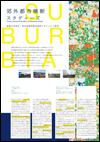 |
|
※PDF(4.64MB)→ |
||
(4)Renovation design of regional public spaces for sustainable residency: Project practice 2011 of Dept. of Architecture and building engineering, Graduate school of urban environmental sciences, TMU /published in Dec.2012 |
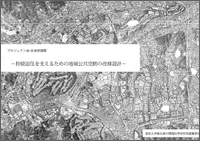 |
|
|
||
(5) Renewal guideline for housing complexes such as Tama Newtown /published in Feb.2012 |
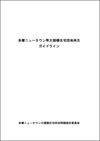 |
|
※PDF(0.7MB)→ |
||
(6)Cross-sectional Studies of Suburban Cities 2 /published in Mar.2012 |
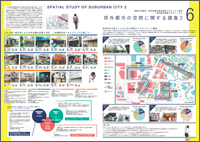 |
|
※PDF(8.04MB)→ |
||
(8)Tama Newtown Story: It's not old town. /published in Sep.2012 |
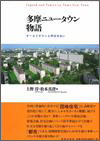 |
|
(9)Common Project Elements Report of research summary in 2011 /published in Mar.2013 |
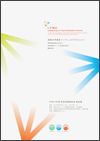 |
|
|
||
(10)Common Project Elements Report of International Symposium on Leading Project /published in Sep.2013 |
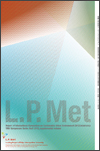 |
|
|
||
(11)Cross-sectional Studies of Suburban Cities /published in Mar.2014 |
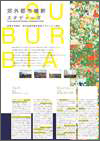 |
|
|
||
(12) Common Project Elements Research Achievement Report of Leading Project of Tokyo Metropolitan University /published in Mar.2014 |
 |
|
|
||



